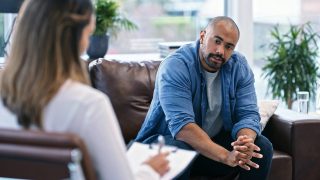
Editor’s note: This article, reprinted with permission, originally appeared in the October 2023 issue of
the FOP Journal, the official publication of the National Fraternal Order of Police (FOP).
In conversations about first responder mental health, PTSD, or post-traumatic stress disorder, is almost always mentioned. In fact, the term “PTSD” has become part of common vernacular in our language, with casual references made when someone endures something that they consider shocking. However, true PTSD is complicated. PTSD is a disorder that meets the diagnostic criteria for post-traumatic stress specified by the American Psychiatric Association in the most recent edition of the Diagnostic and Statistical Manual of Mental Disorders (DSM-5), considered to be the encyclopedia of psychological disorders.
The diagnosis of PTSD is actually quite complex, with eight different criteria that must be met for an official diagnosis.
- Criterion A involves exposure to actual or threatened death, serious injury or sexual violence by either directly experiencing the event, witnessing it in person as it occurs to others, or learning that it happened to a close family member or close friend. Exposures through electronic media, television, movies or pictures don’t qualify unless they are work-related.
- Criterion B involves intrusion symptoms, with the presence of one (or more) of the following associated with the traumatic event(s), beginning after the traumatic event(s) occurred:
- Recurrent, involuntary and intrusive distressing memories of the traumatic event(s).
- Recurrent distressing dreams in which the content of the dream is related to the traumatic event(s).
- Dissociative reactions (e.g., flashbacks) in which the individual feels or acts as if the traumatic event(s) were recurring.
- Intense or prolonged psychological distress at exposure to cues that symbolize or resemble an aspect of the traumatic event(s).
- Marked psychological reactions to cues that symbolize or resemble an aspect of the traumatic event(s).
- Criterion C involves the behavior of the person diagnosed. Specifically, persistent avoidance of stimuli associated with the traumatic event(s), beginning after the traumatic event(s) occurred. This might be efforts to avoid distressing memories, thoughts or feelings about the event, or efforts to avoid people, places, activities or situations that arouse memories of the event.
- Criterion D involves negative alterations in thoughts and mood associated with the traumatic event(s), beginning or worsening after the event(s) occurred. This might be an inability to remember an important aspect of the traumatic event; persistent and exaggerated negative beliefs or expectations about oneself, others or the world; persistent, distorted thoughts about the causes or consequences of the traumatic event(s) that lead the individual to blame himself/herself or others; persistent negative emotional states; inability to experience positive emotions; diminished interest in activities; and feelings of detachment from others.
- Criterion E involves marked alterations in arousal and reactivity associated with the traumatic event(s), beginning or worsening after the traumatic event(s) occurred. This is described by some as hypervigilance and can look like irritable behavior and angry outbursts (with little or no provocation), reckless or self-destructive behavior, exaggerated startle response and problems with sleep or concentration.
In addition to meeting all of these criteria, in order for a person to be diagnosed with PTSD, symptoms must have been occurring for at least one month, and must be causing significant disruptions and lack of functioning in social, work and other important parts of the person’s life. Also, other possible causes of the disruption (alcohol, drugs or other medical issues) must be ruled out.
Years ago, when the world of psychology first established the idea of PTSD, it provided some benefits to those suffering, as they were able to put a name to something that was confusing, frightening and, for some, debilitating. Naming an official diagnosis enabled research into causes and remedies, and facilitated insurance companies beginning to cover treatment. However, the “D” in PTSD, the word “disorder,” discouraged some from seeking care, from revealing their condition and from feeling a sense of honor, even though their PTSD was just as honorable as any physical injury. When an injury is earned in battle, awards are given. There is no Purple Heart or Medal of Valor for PTSD.
As we began to learn that symptoms of post-traumatic stress are treatable, and often recoverable, our thinking about PTSD began to shift. We began to talk more about the condition as PTSI, or post-traumatic stress injury. “Injury” indicates a condition from which we can recover, while “disorder” seems like a label for life.
Psychology is a constantly evolving field. Through further study, in recent years, and especially in law enforcement and other first responder professions, we have begun to learn about and shine a light on the concept of post-traumatic growth. In 1996, psychologists Richard Tedeschi and Lawrence Calhoun coined the term “post-traumatic growth” to capture what they had seen among some individuals who had experienced traumatic events. Post-traumatic growth was characterized by Tedeschi and Calhoun as “the experience of positive change that occurs as a result of the struggle with highly challenging life crises.” They found some commonalities in the experiences of those who reported post-traumatic growth:
- Spiritual changes — deep faith in something greater than self
- Personal strength — building of confidence in what you can overcome
- Relating to others — creation of empathy, recognition of special relationships
- Appreciation of life — gratitude
- New possibilities — seeing things from another angle, new purpose
Modern studies have shown that the majority of trauma survivors do not develop PTSD. This news may well be a game changer for our profession. While first responders are still diagnosed with PTSD at a rate higher than that of the general public, we have at times been led to believe that suffering from post-traumatic stress is an inevitability of the job. Yet this doesn’t have to be the case. So what can lead us toward the path of growth after trauma? Five key ideas have been tied to the tendency to grow after exposure to trauma:
- Education — Learning about oneself and re-evaluating one’s identity and roles. Thinking about what matters most in one’s life and focusing more attention there.
- Emotional regulation — Directing focus to challenging emotions and learning to manage them by thinking about them with self-empathy, patience and faith.
- Disclosure — Speaking openly about one’s experiences of the traumatic event. Talking about events and our reactions to them keeps those experiences from being pushed into the dark where they can be avoided.
- Narrative development — Creating a clear account in your mind of the traumatic experience and sharing your story. Creating a narrative of being a survivor instead of a victim.
- Service — Recognizing a purpose for one’s survival, practicing gratitude and drawing strength from serving others.
Fortunately, several training programs in law enforcement mental health and wellness have begun to focus on growth after trauma. The Boulder Crest Foundation, an FOP vetted and approved wellness provider, has developed a series of programs and training that focus exclusively on post-traumatic growth. The Power in Peers course, developed cooperatively between the FOP and the U.S. Department of Justice COPS Office, is based on concepts of post-traumatic growth and positive psychology. It is past time for us to recognize the strength and resilience that those in our profession already possess and to build on those.
As seen in the November 2023 issue of American Police Beat magazine.
Don’t miss out on another issue today! Click below:





